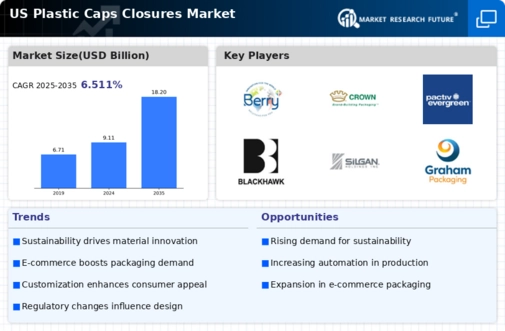Growth in the Beverage Industry
The plastic caps-closures market is closely linked to the expansion of the beverage industry, which continues to thrive in the US. With the increasing consumption of bottled beverages, including water, soft drinks, and alcoholic beverages, the demand for effective and reliable closures is on the rise. Recent statistics indicate that the beverage sector is anticipated to reach a valuation of over $200 billion by 2026, which could translate into substantial opportunities for the plastic caps-closures market. As manufacturers seek to enhance product shelf life and maintain freshness, innovations in closure technology are likely to emerge. This growth trajectory in the beverage industry is expected to drive the demand for diverse closure solutions, thereby shaping the competitive landscape of the plastic caps-closures market.
Rising Demand for Convenience Packaging
The plastic caps-closures market is experiencing a notable surge in demand driven by the increasing consumer preference for convenience packaging. As lifestyles become busier, consumers are gravitating towards products that offer ease of use and portability. This trend is particularly evident in sectors such as food and beverage, where single-serve packaging is gaining traction. According to recent data, the convenience packaging segment is projected to grow at a CAGR of approximately 4.5% over the next five years. This growth is likely to stimulate innovation within the plastic caps-closures market, as manufacturers strive to develop closures that enhance user experience while ensuring product integrity. The focus on convenience is expected to shape product design and functionality, thereby influencing market dynamics significantly.
Regulatory Compliance and Safety Standards
The plastic caps-closures market is significantly influenced by stringent regulatory compliance and safety standards imposed by government agencies. These regulations are designed to ensure that packaging materials meet safety and quality benchmarks, particularly in food and pharmaceutical applications. As consumers become increasingly aware of safety issues, manufacturers are compelled to adhere to these standards, which may lead to increased production costs. However, compliance can also serve as a market differentiator, as products that meet or exceed safety standards are likely to gain consumer trust. The ongoing evolution of regulations may prompt innovation in materials and design within the plastic caps-closures market, as companies strive to align with safety requirements while maintaining cost-effectiveness.
Technological Innovations in Closure Design
The plastic caps-closures market is being propelled by ongoing technological innovations in closure design and manufacturing processes. Advances in materials science and engineering are enabling the development of closures that offer enhanced functionality, such as tamper-evidence and child-resistance features. These innovations are particularly crucial in sectors like pharmaceuticals and food, where safety and security are paramount. Furthermore, the integration of smart technology into closures, such as QR codes for tracking and authentication, is emerging as a potential game-changer. As these technologies evolve, they are likely to create new opportunities for differentiation within the plastic caps-closures market, allowing manufacturers to cater to the evolving needs of consumers and regulatory bodies.
Shift Towards Lightweight Packaging Solutions
The plastic caps-closures market is witnessing a shift towards lightweight packaging solutions, driven by both environmental considerations and cost efficiency. As companies aim to reduce their carbon footprint, lightweight closures are becoming increasingly popular due to their lower material usage and reduced transportation costs. This trend is particularly relevant in the food and beverage sectors, where minimizing packaging weight can lead to significant savings. Recent analyses suggest that lightweight packaging can reduce overall packaging costs by up to 15%, which is likely to attract manufacturers to invest in innovative closure designs. This shift not only aligns with sustainability goals but also enhances the competitive edge of products in the plastic caps-closures market.

















Leave a Comment